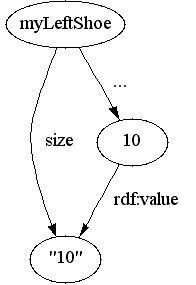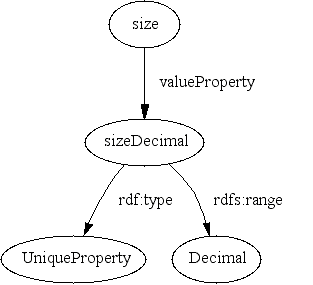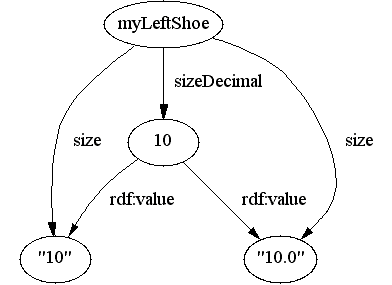
W3C Semantic Web Dev. DAML joint-committee
note: this is no longer (Oct 2002) my favorite design for using XML Schema datatypes in RDF. I now prefer datatype properties, aka Interpretation Properties, and their use in, for example, semantic web travel tools.
Consider this little ontology about a shoe and its size:
<rdf:RDF xmlns:rdf="http://www.w3.org/1999/02/22-rdf-syntax-ns#" xmlns:rdfs="http://www.w3.org/2000/01/rdf-schema#" xmlns="http://www.daml.org/2000/12/daml+oil#" xmlns="#"> <rdf:Description about=""> <rdfs:comment>What I know about shoes</rdfs:comment> </rdf:Description> <rdfs:Class about="#Shoe"/> <daml:UniqueProperty about="#size"/> <Shoe about="#myLeftShoe"> <size>10</size> <size>10.0</size> </Shoe> </rdf:RDF>
Have I stated a contradiction? Or have I just said that "10" = "10.0"? The latter is, intuitively, closer to what I meant.
This issue, regarding "IEEE floating point numbers, Integers, Boolean values, Dates and Times, etc.", known as c21 in the RDF Schema Working Group, was deferred pending a general solution for primitive datatypes in XML. Now we have such a solution at Candidate Recommendation status: XML Schema Part 2: Datatypes. This document is an attempt to apply that solution to RDF and DAML+OIL.
In that specification, a dataype pairs a set of values with a set
of lexical representations. In our example, 10 and
10.0 are lexical representations for the same point in the value
space of the decimal datatype.
This notion of lexical representation corresponds neatly to the
value property from section 2.3 of [RDF@@]:
10.0
as [rdf:value "10.0"]
(sorry; I slipped into notation 3; if you're not familiar, see the primer)
http://www.w3.org/2000/10/XMLSchema#decimal for the decimal
datatype(dtnames).So that the value corresponding to the numeral 10.0 can be
written
<xsd:decimal xmlns:xsd="http://www.w3.org/2000/10/XMLSchema#"> <rdf:value>10.0</rdf:value> </xsd:decimal>
or
[ a xsd:decimal; rdf:value "10.0" ]
or in diagram form: figure 1 shows the
shoe, the decimal number 10 and the numeral 10:

Note that in each primitive XML datatype, lexical representations are unambiguous. That is:
rdf:value util:unambiguousOver xsd:string, xsd:boolean, xsd:float, xsd:double, xsd:decimal, xsd:timeInstant, xsd:timeDuration, xsd:recurringInstant, xsd:binary, xsd:uri.
where
(<=> (PropertyValue ?p unambiguousOver ?c)
(forall (?x ?y ?v)
(=> (and (Type ?x ?c) (Type ?y ?c)
(PropertyValue ?p ?x ?v)
(PropertyValue ?p ?y ?v))
(= ?x ?y)))))
Then we can introduce a property that relates size, whose
value is a string, to another property whose value is a decimal:
(forall (?p ?vp ?x ?s)
(=> (and (PropertyValue valueProperty ?p ?vp) (PropertyValue ?vp ?x ?s)
(exists (?v) (and (PropertyValue ?p ?x ?v) (PropertyValue ?v ?s))) ) )
A property and a class uniquely determine a value property(keys):
(forall (?p ?vp1 ?vp2 ?c)
(=> (and (PropertyValue valueProperty ?p ?vp1)
(PropertyValue valueProperty ?p ?vp2)
(PropertyValue rdfs:range ?vp1 ?c)
(PropertyValue rdfs:range ?vp2 ?c)
)
(= ?vp1 ?vp2) ) )
Using this property, we can state the intended constraint on shoe size as:
<rdfs:Property about="#size">
<util:valueProperty>
<daml:UniqueProperty about="#sizeDecimal">
<rdfs:range
rdf:resource="http://www.w3.org/2000/10/XMLSchema#decimal"/>
</util:valueProperty>
</rdfs:Property>
so having size 10 and size 10.0 is not a
contradiction, but having size 10 and size 11 would
be, since 10 and 11 denote different decimals, and sizeDecimal is unique.
These diagrams show the sizeDecimal property related to the size property and the two numerals related to the number and the shoe:
 figure 2 |
 figure 3 |
That 10 and 11 denote different decimals should
be specified in a set of axioms derived from XML Schema Part 2:
Datatypes. (yes, that's a lot of work, but it should be very
valuable as quality assurance for that spec.) For example, strings are
their own values:
(forall (?s ?v)
(=> (and (PropertyValue rdf:type ?v dt:string)
(PropertyValue rdf:value ?v ?s) )
(= ?v ?s) ) )
This section sketches the design, but does not exhaustively enumerate the details.
We can express "decimals greater than 10" by using XML schema facets as properties of classes:
<rdfs:Class ID="over12"> <!-- over12 is an XMLS datatype based on positiveIntege --> <!-- with the added restriction that values must be >= 13 --> <rdfs:subClassOf rdf:resource"#positiveInteger"> <dodt:minInclusive value="13"/> </xsd:simpleType>
where postitiveInteger is defined/described ala
<rdfs:Class rdf:about="#positiveInteger"> <rdfs:subClassOf rdf:resource"http://www.w3.org/2000/10/XMLSchema#decimal"/> <dodt:minInclusive>1</dodt:minInclusive> <dodt:scale>0</dodt:scale> </rdfs:Class>
and the dodt: namespace is a translation of the XML Schema datatype facets into DAML+OIL. For example:
<rdfs:Property about="#minExclusive">
<rdfs:domain resource="...rdfs#Class"/>
<rdfs:comment>axioms:
(forall (?c ?m ?v)
(=> (and (PropertyValue rdf:type ?v ?c)
(PropertyValue minExclusive ?c ?m) )
(> ?v ?m) ) )
</rdfs:comment>
</rdfs:Property>
XMLSchema#xpointer(id("float") but there's an
outstanding request to simplify that to just
...XMLSchema#float.